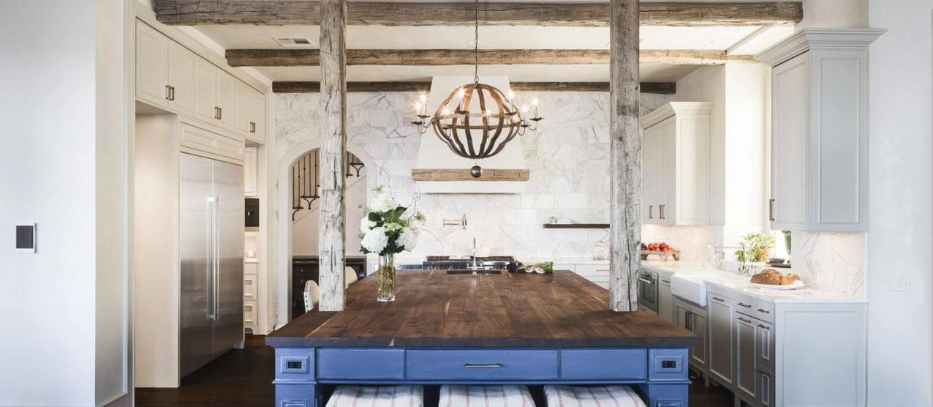
There are more choices on the market for kitchen countertops today than ever before. Every few years, a new product gets introduced. A few end up having staying power, while most tend to vanish again as quickly as they arrived.
Ready to Discover More?
Your next project is just around the corner. Browse our product galleries for more inspiration.
One of the oldest countertop materials, and with arguably the most staying power, is wood. Wood kitchen countertops have a long history, along with beauty and versatility that means that they’re still in general use today. The choice to add wooden countertops or an island top to your interior design brings in natural color tones and beauty that plays well with multiple home styles, from modern kitchens to rustic kitchens. We are seeing an upward trend in new and reclaimed wood kitchen building materials because of the warm and inviting atmosphere they help cultivate.
Unlike wood flooring or paneling, however, solid wood countertops aren’t as straightforward as people would believe. A wood countertop is actually pieced together from multiple smaller pieces of solid wood. And while you might be able to complete a DIY install of wooden countertops, it requires a woodworking professional to craft this solid wood product. Wooden countertops are custom crafted to the exact specifications needed by gluing full-length boards together to achieve the size requirements. After the top is sized, it gets an edge detail in the appropriate sides followed by sanding that will prepare the top for a variety of applicable finishes. This is part of what brings a lot of the charm and beauty of a wood countertop, but it also makes for more choices for the homeowner to have to make.
History of Wood Countertops
Wood countertops actually came about as cutting surfaces for butchers. This is where the term “butcher block” comes from. The first wood countertops were actually large tree stumps that had been cut smooth. They didn’t last long, however, and butchers needed to replace them frequently.
Eventually, it was discovered that taking sugar maple pieces and gluing them together to form a single surface created a denser, harder chopping block. Butchers were able to use the blocks longer, and cuts could even be sanded out.
The idea that a durable countertop could be formed out of wood using the same methods followed shortly thereafter. This led to the butcher block countertop that is still being used today, along with a variety of other styles of wood countertops.
Wood Countertop Styles
There are essentially three different methods of constructing a wood countertop. Each one gives the material different characteristics as well as a distinct look.
Edge grain
The first type uses pieces of wood positioned so that the long cut ends are visible at the top. The pieces of wood are roughly 1 to 2-inches in width, which gives a lot of grain, movement, and variation to the countertops, but because these are the cut ends, they also have a more distinct appearance than a single plank or piece of natural wood. This is the most common type of butcher block countertop.
End grain
The second type uses the short cut ends, which can make the countertop look a lot like a checkerboard. Sometimes the pieces of natural wood will be stained in alternating colors to further enhance this effect. By using the short-cut ends, you can get a stronger, more durable countertop, as well as a countertop of varying thicknesses.
Face Grain
The final style is the most decorative and uses face planks of wood pieced together. These pieces of wood may be the same width or a variety of different widths, measuring from 2 to 8-inches wide. This allows the most grain variation and movement to show and gives more choices for edge styles for the countertop.
All three styles can be made of different natural wood species, finished with different stains, and can be shaped in different ways.
Maintenance and Durability
The way that a countertop looks and the way that it functions are equally important to know. Most countertops used today have some type of maintenance involved, and wood is no different.
If your wood countertop is unfinished, meaning that it has not been given a stain or protective finish, you will need to oil it monthly. The mineral oil will penetrate the wood, and help keep it supple while preventing some stains.
All wood countertops may absorb some liquids, even those that have been finished, so you need to keep an eye on the countertop, and wipe up spills as soon as you see them. You’ll want to stay aware of highly acidic spills in particular, as these may affect the glue that holds your countertop together.
Like all wood, your wood countertop may swell and contract with humidity. Some wood species may also darken in color when exposed to sunlight and humidity. This is normal, and part of the beauty of having a wood countertop in your home.
If your countertop becomes scratched, scraped, or even burned, these marks can be sanded out of the countertop, and a new finish can be applied to disguise the marks. While on the one hand, this does make wood countertops slightly higher in maintenance than some other materials, on the other, it also means that you can renew your countertop fairly easily, enabling it to last for many years.
Wood is, in fact, a great option for kitchen countertops on many levels. The wood can be repaired if scratched or damage occurs, the surface is easy to work on and clean up after food prep, and the wood countertops are manufactured out of sustainable, eco-friendly sources. If cared for and maintained properly, wood countertops will stand the test of time and anything else you can throw at them.
Wood Grains, Colors, and Finishes
Several wood species are available in both newly milled and reclaimed woods to create the exact color and texture that will jive with the desired design of the kitchen remodel. Wood species each have their own characteristics, color, and grain patterns. This means that you have a lot of choices when it comes to choosing your wood countertop.
All woods have a rich, warm color to them, but they can range in grain and tone. For example, white oak has a gray undertone with a moderate grain pattern, while hickory has a creamy white color with a very dark, wild grain. Cherry has a very rich, warm color and a close grain, while pine has a lot of natural knot holes that can give the countertop an antique or rustic look.
It’s also important to think about how you will use your wood surface in order to determine what the best finish option will be to protect the wood. If you plan to use the surface directly for food prep, it would be recommended to utilize a natural oil that is formulated to specifically be used in a food-safe way. If it is more likely that you plan on using the top for general use, you may be inclined to have a traditional water-based product applied that will ultimately require less maintenance than a surface used for food prep.
Wood can be contemporary, traditional, formal, or rustic depending on the grain and the finish. This lets it work well in nearly any kitchen or space.
Wood Kitchen Countertop Design Ideas
Seeing is believing when it comes to determining the many ways that you can utilize a wood countertop. From rustic, reclaimed wood countertops that show marks of their previous use, to new cut wood countertops with a variety of wood types and stains, wood countertops can makeover your kitchen in a variety of ways. Wooden countertops can be utilized for kitchen countertops, island tops, bar tops, tabletops, and even unique vanity tops. These 9 design ideas can help give you a glimpse into the many home improvement possibilities for your kitchen.
1. Butcher Block Style
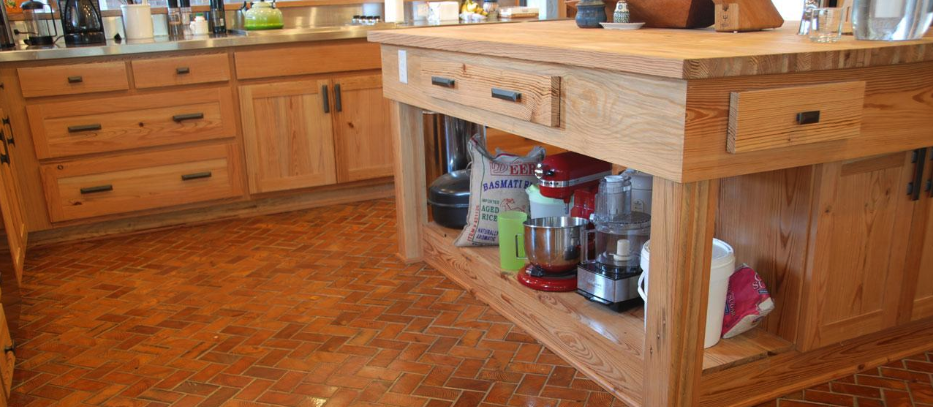
This kitchen island countertop is made from reclaimed heart pine – the hardest, and most instantly recognizable softwood. The countertop matches the color of the kitchen cabinets, giving the kitchen a subtle uniformity. The reclaimed pine has a soft finish that complements the rustic nature of the room.
2. Contrasting Countertop
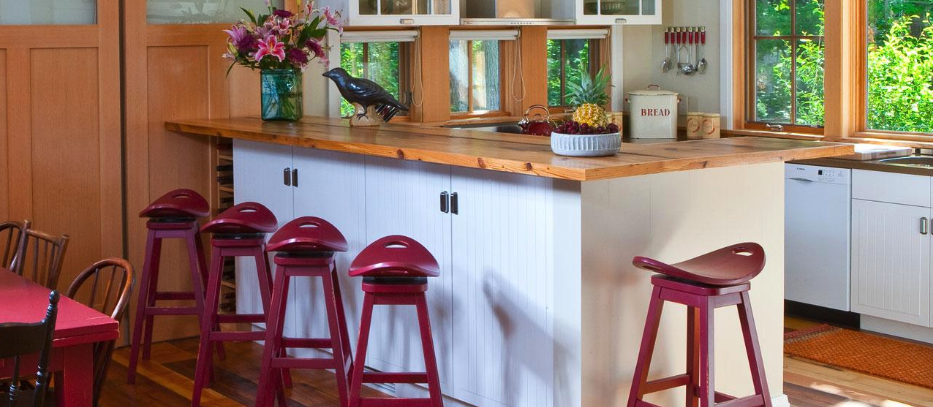
This island countertop is also made of reclaimed heart pine. Here, however, it’s given a very different look by contrasting white kitchen cabinets. This heart pine has a rich luster, along with a slightly rustic look that lets the knot holes show.
3. Smooth and Sleek
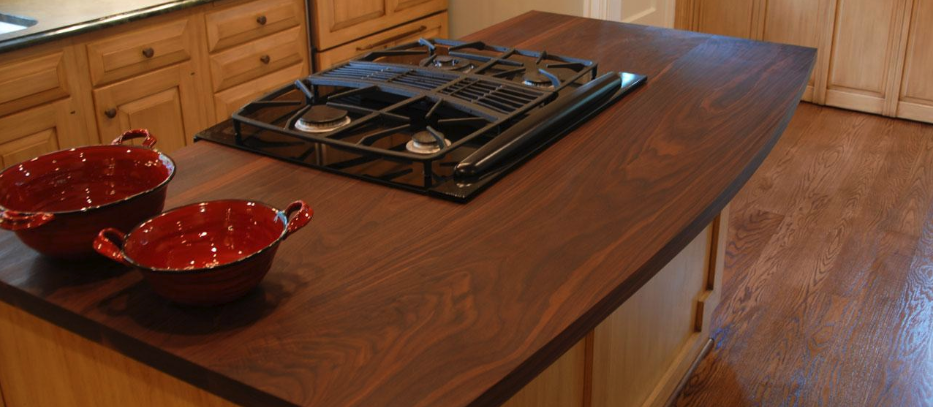
Wood countertops don’t have to be rustic to be beautiful. Sustainably harvested American walnut is an ideal wood species when looking for a dark tone countertop. The natural color of the Walnut turns to a warm chocolate brown when the natural oil is applied and the wood is a timeless option for just about every design style. This walnut countertop has a rich, dark finish that’s also been given a sleek edge with one rounded side. Against all the other light wood in the kitchen, the walnut stands out as a focal point.
4. Perimeter Countertop
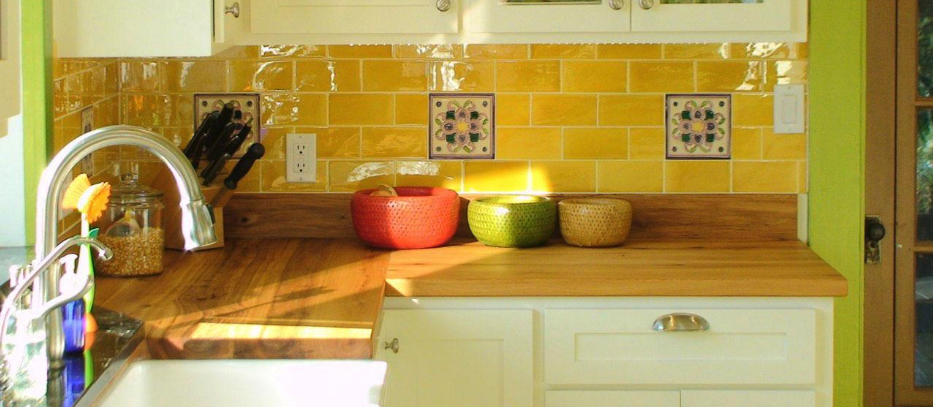
While many people choose to use wood countertops on the kitchen island, they can also be used with great effect on the perimeter cabinetry as well. This look is particularly effective in craftsman style homes, as well as modern farmhouse and cottage styles. This antique elm countertop perfectly complements the yellow backsplash and white cabinets, brightening up the kitchen.
The natural warmth and durability found in reclaimed elm lend themselves to being a great option for reclaimed wood kitchen countertops. The long straight grain of reclaimed Elm provides just the right amount of character to create a truly timeless countertop. The image above is finished in clear, but a light stain can be added in order to produce the exact color tones needed for the space.
5. Smooth Curves
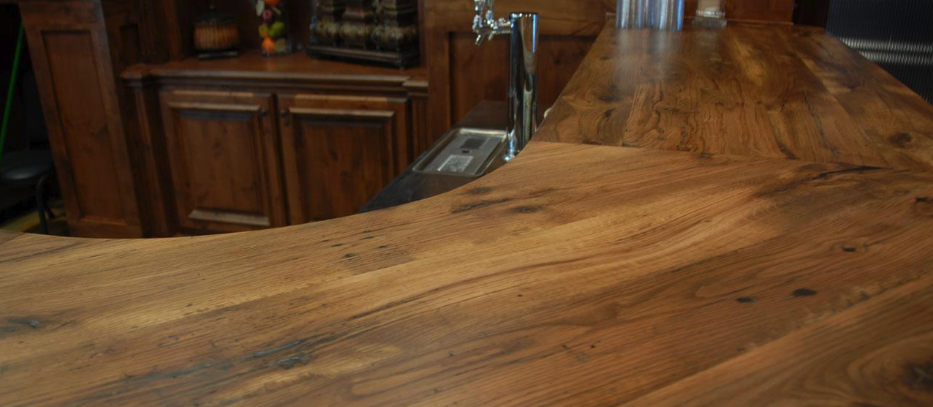
One of the benefits of wood is the way that it can be cut, polished, and shaped to follow any curve. This reclaimed hickory countertop curves smoothly around one side, giving better accommodation to the user. The prominent grain of the wood helps complement the sleekness of the design, emphasizing the shape.
6. Rustic Focal Point
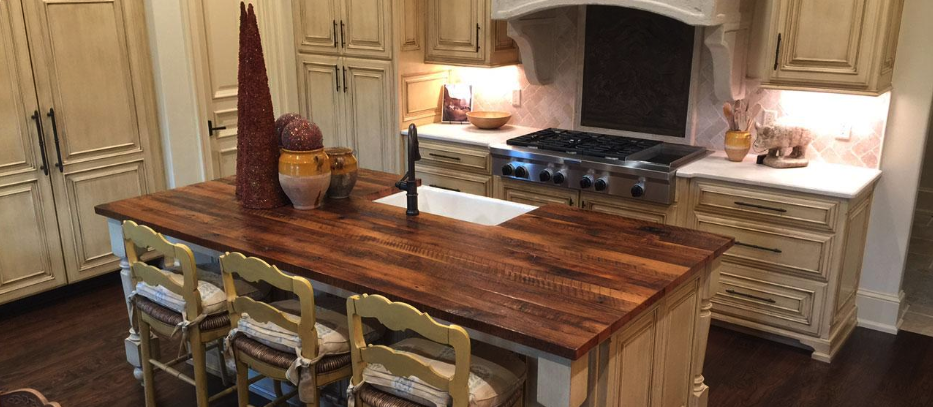
This rustic kitchen uses an antique oak countertop to add some focus to the center of the room. The wood island top was crafted from reclaimed rustic oak and it brings together a wide range of natural colors and textures that developed over the last century. The oak still shows the saw marks from its original use, adding interest and depth to the design, while contrasting to the more formal cabinetry. This countertop helps anchor and complete the kitchen design.
7. Center Contrast
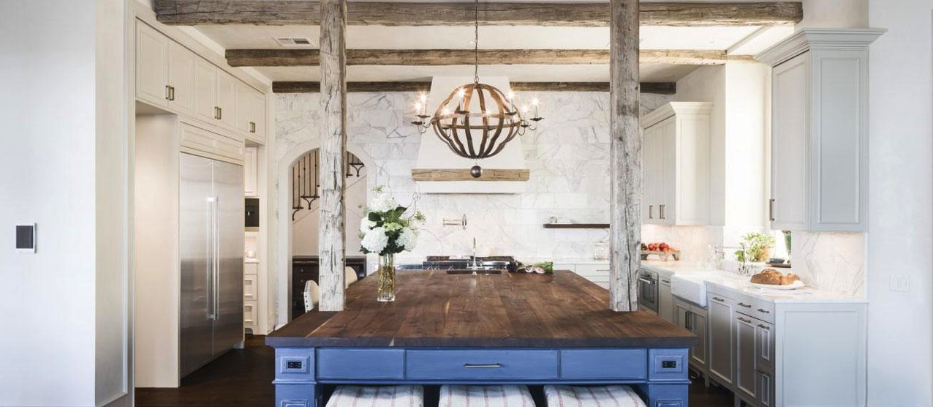
This kitchen features several unique and interesting design elements, such as the hand hewn antique wood beams. The countertop needs to hold its own, and tie together the various finishes in the room. The natural brown tones found in the traditional Walnut island top pair nicely with the energetic pop of color in the island base and the organic aged patina of the reclaimed hand hewn beams. The large island is made from sustainably harvested American Walnut from the Midwest and is finished with a low sheen natural mineral oil that can be maintained with ease. The rich color of the wood picks up the darker colors in the room, while the sleek surface and smooth finish add a little contrast that balances the design.
8. Light Contrast
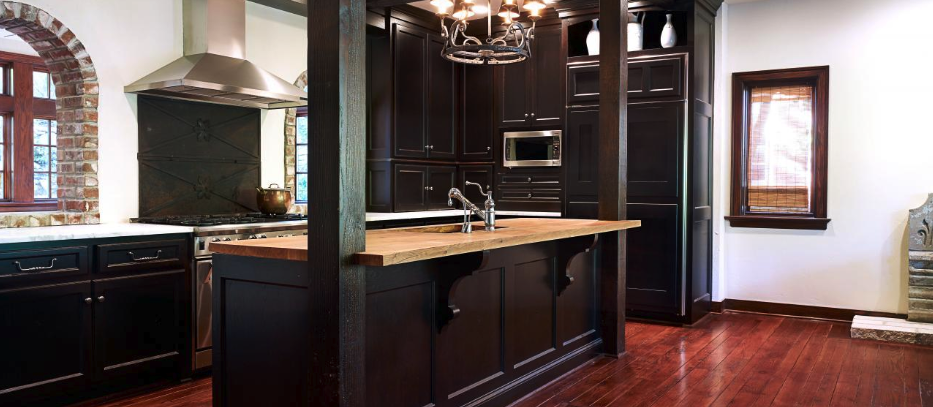
Reclaimed oak is prized for many reasons, but when it comes to the kitchen it’s because of its extreme durability and stability. The woods are full of character from the natural slow growth cycle as well as the decade spent of life in a hay barn. This kitchen features a lot of dark wood and rich colors. A dark countertop would only overwhelm the room, so this antique oak countertop provides a much needed contrast. The lighter finish of the countertop helps it hold its own in a room full of wood finishes, but the color is unique to the area, which also lets it stand out.
9. Antique Accent
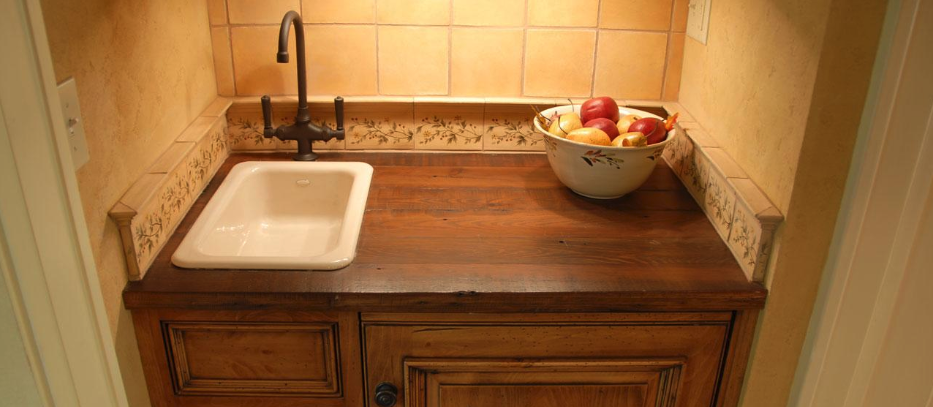
Kitchens today don’t just feature a single countertop area and sink. Instead, they have different countertop materials and additional bar or utility sinks for added function. This little utility sink nook has an antique pine countertop that helps create a cozy feeling. The patina of the wood matches the finish of the cabinet perfectly, while also complementing the small tile backsplash.
Complete Your Kitchen with a Wood Countertop
Wood countertops are beautiful, durable, and available in a wide range of different styles. With the nearly universal appeal that wood has as a building material, it’s no wonder that wood countertops still make the list of top additions to a kitchen remodel. Wood countertops require only moderate maintenance and can last for decades when cared for properly. Whether you choose something modern or rustic, there’s no denying that the beauty of a real wood countertop will enhance your kitchen design now and well into the future. When you’re ready to start planning your home improvement project, contact the team at Elmwood Reclaimed Timber! We’ll help you identify the right wooden countertop for your kitchen remodel project.
